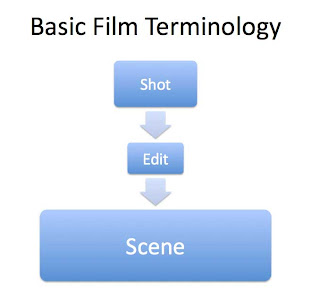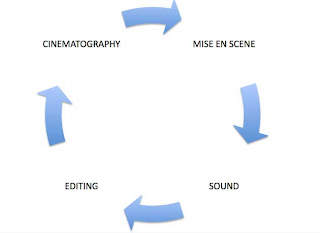
Thursday, November 3, 2011
Tuesday, October 18, 2011
Thursday, October 13, 2011
Thursday, October 6, 2011
Study for Creative Media test
Thursday, August 11, 2011
Questions for film project
8. Discuss whether you undertook adequate and detailed reflection to throughout your project. Have you provided enough evidence to support your work? (Look back at your blogs/journals and think about whether it looks like 6 weeks worth of work).
Discuss your feelings about the production task:
9. Are you satisfied with your groups final result?
10. Would like to change any aspects of your film?
11. If you could start the project again what would you do differently?
Tuesday, August 9, 2011
Creative Media Assignment
Thursday, July 14, 2011
IMOVIE SHORT CUTS
SPACE BAR: PLAY VIDEO AND STOP
COMMAND T CUTS VIDEO
COMMAND E EXPORT MOVIE
COMMAND G PLAY FULL SCREEN
LEFT ARROW OR RIGHT ARROW PLAY MOVIE FRAME BY FRAME
HOLD DOWN CONTROL KEY FREEZE THE PLAYHEAD
COMMAND N CREATE NEW PROJECT
COMMAND C COPY SELECTED FRAMES
COMMAND X CUT SELECTED FRAMES
COMMAND V PASTE SELECTED FRAMES
I OPEN CLIP ADJUSTMENTS PANE OF INSPECTOR
COMMAND Z UNDO LAST WORK
Thursday, March 17, 2011
Shots
Shots

This shot shows the props being used and the facial expression.
First, the props used is a tie, a formal looking uniform and a bottle. It looks as if the person is nervous about something due to them holding his tie in that way. It shows he is stressed. Also, the bottle seems to look as if it is alcohol, so it should he is nervous again about something.
Thursday, February 17, 2011
Moulin Rouge
MISE EN SCENE:
Lighting- stage lighting, colours show the mood of the actors and the scene, spotlights, strong colour/artificial
Setting- looks like a theatre
Props- exaggerated props to intensify the mood
Acting- dance/strong body language
SOUND:
singing, orchestra, sound effects
EDITING:
cuts, dissolves (for a fading memory)
CINEMATOGRAPHY:
high contrast exposure
METHOD
Tuesday, February 15, 2011
2. Here are some of the categories for the annual Academy Award Winners. Each winner gets an Oscar. Look back over the past few years – not just this year – and note down who you would give your awards to for as many as you can of the categories below.
Best film: 21, Marie Antoinette, Memoirs of a Geisha, Remember the Titans, Pay It Forward, The Green Mile, K-XAP, Terminal,
Best Actor: Johnny Depp, Leonardo DiCaprio,
Best Actress: Rachel McAdams, Anne Hathaway,
Best Supporting Actor: Ted Levine (Silence of the Lambs),
Best Supporting Actress
Best Director: Tim Burton
Best Original Screenplay (script)
Best Screen Adaptation
Best Cinematic Photography
Best Editing
Best Special Effects
Best Original Score (music)
Best Costumes / Wardrobe: Marie Antoinette
Best Costumes / Wardrobe
Best Title Sequence / Credits
Best Short (film)
Special Award for Services to the Cinema Industry, the motion picture business, the dream
factory, the movie world.
Worksheet Film
1. On the right are some of the ways we classify films. On the left are some film titles. Match
each title with the most appropriate kind of film from the column on the right.
| FILM | GENRE |
|
Titanic | A crime movie |
|
The Simpsons |
a thriller |
|
FRIDAY THE 13TH |
CARTOON |
|
27 DRESSES |
a historical film |
|
WILD WILD WEST |
a (Hollywood) musical |
|
BRAVE HEART |
a science fiction movie |
|
MOULIN ROUGE |
a war film |
|
ARMAGEDDON |
a horror film |
|
BLARE WITCH |
Epic/Historical |
|
INDIANA JONES |
a romantic comedy |
|
SAVING PRIVATE RYAN |
western |
|
ALIEN |
a documentary |
|
THE GOD FATHER |
ADVENTURE |
|
LIFE OF JOHN BUTLER |
a disaster movie |
|
CASABLANCA |
ROMANCE |
Monday, February 14, 2011
SHANGHAI NOON
Mise en scene:
Sound: Birds tweeting (time of day, sense of place)
Sound of weapons- suspense, anticipation
Music- Western, fast paced
Props: Horses, guns, clothing, hats, knife- enhanced the comedy elements (clumsiness) also setting the scene
Setting: Country- landscape, paddock, lake, timber, shack- enhances the serenity and creates contrast
Lighting: Natural, sunny, warm
Acting: Stupid cowboys, not the usual cowboys (comedy)
Comedy dialogue, body language- playful, relaxed
Editing:
Cuts, rhythm slow to fast when playing with weapons
Shot types- over the shoulder, wide, long, low
Thursday, February 10, 2011
Genre
Monday, January 31, 2011
Notes on film 1/02/11

Wide shot- use to show the scene
Medium shot- to give you an idea of their personality
Close up- facial expression
Extreme close up-
Low angle- on the ground, power for the character
High angle- opposite of low angle, makes the character look inferior and the audience feel power
 The shot type- This shot is a low angle, over the shoulder.
The shot type- This shot is a low angle, over the shoulder.The angle of the shot- Low angle
The intention of the shot?- to show that the Queen has power over the frog and that she is superior to him
Describe in detail the visual clues or conventions used to convey meaning- The visual clues seen in this shot to convey the message ranges from the makeup to the shot angle and type. The make-up gives a visual clue by showing us her power with the strong blue and the red hair. It draws attention to her, rather that the frog in front of her. Also, the frog is smaller that her to also show the queens power. We feel empathy to the frog.

The shot type- low angle, wide shot
The angle of the shot- low angle
The intention of the shot?- to show what he is doing and why he is up there. To show the window above him. To show how he is almost boxed in and can't get out. To show the height of the files and how he is high up. To create suspense
Describe in detail the visual clues or conventions used to convey meaning- The dull colors suggest he is in a depressing or bad place, where he doesn't want to be and the lab coat says he is in a hospital or lab or mental institution.
Loose talk is noose talk suggests he is crazy.

The shot type- medium shot type
The angle of the shot- close up
Intention of the shot- to show his emotion and to show his face and eyes. To be excited with him and happy as he is.
Visual Clues- It shows he is a happy man because the background is dull and dark but he's face is shining and happy and his clothing and make-up is bright and makes you happy. To show he is a happy man. To show he is mad, because of the gapped tooth, wonky eye and the crazy hair etc
To show he is also a good guy because he is bright compared to the dark scene behind him.

The shot type- High angle, over the shoulder shot
Angle of the shot- High angle, over the shoulder
Intention of the shot- To show how Alice is small and doesn't have any power. How the Chesher cat has more power over her or more knowledge in this case
Visual Clues- Very dull background and Alice stands out, but not by much. She blends in and doesn't have that much power or knowledge right now.
Thursday, January 27, 2011
Notes on 28/01/11
- analyzing how images and sound are used to tell a story.
- understanding how codes, conventions and stylistic devices create viewer responses.
- consciously identifying our unconscious responses.
Cinema is a visual art form. Cinema is not literature. A film is not a novel.



Edit:
- An edit is a break in the film where one shot ends and the next shot begins.
- The four common types of edit are:
- Cuts
- Dissolves
- Fades
- Wipes (occasionally)
Way of film for my film: Introduce the characters (close up) Introduce the context (pan out) To empathize with the character (looking down)
A scene:
- A scene is a collection of shots, arranged through editing, into a specific order. (usually 2 or 3 minutes)
- When reading film it is common to analyze individual scenes rather than specific shots
- A scene with two characters having a conversation would likely consist of fewer shots than a fast paced car chase
Go on blackboard and find The Shot Type.
FILM LANGUAGE:
elements used to elicit an emotional response in the audience

Cinematography- The way the film is used eg a Dolley
Sound- Very important, helps the viewer see what is happening in a scene
MISE EN SCENE: put in scene
This is the combination of all the visual elements within the frame (frame: the physical boundary that contains what the audience sees)
PROPS- visual symbols that makes us see what is going on with the film and scene
Today, we learnt a lot about the actual shooting of a film and the way that the movie is edited it a specific way to what the director wants the viewer to feel. Filming has a lot to do with the emotions that the director wants to portray.





